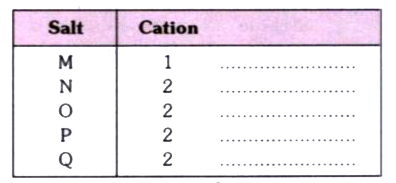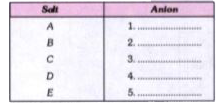Salts M, N, O, P and Q undergo reactiom (i) to (v) respectively.
Identify the cation present in these salts on the basis of these reaction. Tabulate your answer in the format given below.
1. When sodium hydroxide solution is added to the salt M, and heated strongly a colourless gas with a pungent smell is evolved which turm red litmus paper blue and gives dense white fumes with a moist glass rod with hydrochloric acid.
2. Addition of dilute hydrochloric acid to a solution of N gives a thick white precipitate which is soluble in hot water.
3. When ammonium hydroxide solution is added to the solution of 0 a light blue precipitate is obtained which is soluble in excess of ammonium hydroxide to form an inteme deep blue solution.
4. When ammonium hydroxide solution is added to the solution of P reddish brown (mustard colour) precipitate is obtained which ,is insoluble even in the excess of ammonium hydroxide solution.
5. When sodium hydroxide solution is added to the solution of Q a which coloured gelatinous precipitate is obtained which is soluble in excess of sodium hydroxide to form a clear solution

Step by step video & image solution for Salts M, N, O, P and Q undergo reactiom (i) to (v) respectively. Identify the cation present in these salts on the basis of these reaction. Tabulate your answer in the format given below. 1. When sodium hydroxide solution is added to the salt M, and heated strongly a colourless gas with a pungent smell is evolved which turm red litmus paper blue and gives dense white fumes with a moist glass rod with hydrochloric acid. 2. Addition of dilute hydrochloric acid to a solution of N gives a thick white precipitate which is soluble in hot water. 3. When ammonium hydroxide solution is added to the solution of 0 a light blue precipitate is obtained which is soluble in excess of ammonium hydroxide to form an inteme deep blue solution. 4. When ammonium hydroxide solution is added to the solution of P reddish brown (mustard colour) precipitate is obtained which ,is insoluble even in the excess of ammonium hydroxide solution. 5. When sodium hydroxide solution is added to the solution of Q a which coloured gelatinous precipitate is obtained which is soluble in excess of sodium hydroxide to form a clear solution by Chemistry experts to help you in doubts & scoring excellent marks in Class 10 exams.
Updated on:21/07/2023Topper's Solved these Questions
- PRACTICAL CHEMISTRY BOOK - ICSECHAPTER - PRACTICAL CHEMISTRY EXERCISE - Questions from Previous ICSE Board Papers (2008)
5 Videos
- PRACTICAL CHEMISTRY BOOK - ICSECHAPTER - PRACTICAL CHEMISTRY EXERCISE - Questions from Previous ICSE Board Papers (2009)
5 Videos
- PRACTICAL CHEMISTRY BOOK - ICSECHAPTER - PRACTICAL CHEMISTRY EXERCISE - Additional Questions for Practice
23 Videos
- PERIODIC TABLE (PERIODIC PROPERTIES AND VARIATION OF PROPERTIES)BOOK - ICSECHAPTER - PERIODIC TABLE (PERIODIC PROPERTIES AND VARIATION OF PROPERTIES)EXERCISE - UNIT TEST PAPER 1-Periodic Table
22 Videos
- QUESTION PAPER 2022 TERM 1BOOK - ICSECHAPTER - QUESTION PAPER 2022 TERM 1EXERCISE - MULTIPLE CHOICE QUESTIONS
40 Videos
Similar Questions
Identify the following substances :
An alkaline gas which gives dense white fumes with hydrogen chloride.
View SolutionA white solid P, on strong heating, decomposes to give reddish brown gas R and a residue Q. The residue R is yellow when hot and white when cold. The solution of white solid P in water gives white precipitate S, with concentrated sodium hydroxide. The white precipitate S dissolves in excess of sodium hydroxide solution to form colourless solution.
Another sample of the solid P in water is mixed with ferrous sulphate solution and then to this solution are added a few drops of conc. sulphuric acid. A brown ring is formed at the junction of liquids. Answer the following questions:
Identify the solid P.
View SolutionSalts A, B, C, D and E undergo reactions (i) to (v) respectively. Identify the anion present in these salts on the basis of these reactions. Tabulate your answers in the format given below:
(i) When silver nitrate solution is added to a solution of A, a white precipitate, insoluble in dilute nitric acid, is formed.
(ii) Addition of dilute hydrochloric acid to B produces a gas which turns lead acetate paper black.
(iii) When a freshly prepared solution of ferrous sulphate is added to a solution of C and concentrated sulphuric acid is gently poured from the side of the test-tube, a brown ring is formed.
(iv) When dilute sulphuric acid is added to D a gas is produced which turns acidified potassium dichromate solution from orange to green.
(v) Addition of dilute hydrochloric acid to E produces an effervescence. The gas produced turns lime water milky but does not affect acidified potassium dichromate solution.

View SolutionIn period 2, element 'A' is to the right of element 'B'.
The element 'A' would probably have a ____ [smaller/larger] atomic size than 'B'.
View SolutionIn the Periodic Table, elements of Period 3 are arranged in the increasing order of ionization potential as:
View SolutionA sodium salt (A) is heated with cone. Sulphuric acid. The evolved gas truns moist litmus paper red and producess white fumes in contact with a glass rod moistened with ammonia solution. It also gives white precipitate when passed through AgNO_(3) solution. When the salt is heated with MnO_(2) and cone. H_(2)SO_(4) , a gas with an irritating smell is evolved which turns starch-iodide paper blue. Identify the salt and the gaseous product evolved from it. Explain your answer with relevant chemical equations.
View SolutionAn inorganic salt when heated evolves colured gas which bleaches moist litmus paper. The evolved gas is :
View SolutionAn inorganic salt when heated with concentrated H_(2)SO_(4) evolves a colourless pungent smelling gas but with concentrated H_(2)SO_(4) " and" MnO_(2) , evolves a cxoloured pungent smelling gas which bleaches moist litmus paper. The coloured gas is :
View SolutionAn inorganic salt when heated evolves a coloured gas which bleaches moist litmus paper. The evolved gas is
View SolutionBaCl_2 solution gives a white ppt. with a solution of a slat, which dissolves in dil. HCl with the evolution of a colourless, pungent smelling gas. The radical in the salt is
View SolutionOn strongly heating, a blue salt leaves a black residue. Which of the following cations can be present in the salt?
View SolutionSalt (A) is a white deliquescent solid. On heating the solid, brown fumes were evolved. On adding NaOH to the salt solution of (A), a white gelatinous ppt. was obtained. On adding, a drop of blue litmus solution to the ppt., a blue lake was obtained. On adding DPA to the salt solution, a deep blue colouration was obtained. Identify the salt and give the equations involved.
View Solution(i)When silver nitrate solution is added to a salt solution of (A), a black precipitate is - obtained. (A) decolourizes acidified permanganate solution. Identify the acid radical in (A) (ii) On heating the salt, decripitation takes place. On heating a mixture of salt, manganese dioxide and conc. H_2SO_4 , a greenish yellow gas is evolved. The gas evolved turned moist blue litmus red and then turned it colourless. On performing the flame test, the salt imparted a crimson red colour to the flame. Identify the cation and anion in the salt.
View SolutionAn inorganic salt when heated evolves a colourless gas which bleaches moist litmus paper. The evolved gas is :
View SolutionOn being strongly heated, a blue salt leaves a black residue. Which of the following cations can be present in the salt?
View SolutionA metal whose alloy finds use in the construction of air crafts in the powdered form is added to sodium hydroxide solution. A colourless gas was evolved. After the reaction was over, the solution was colourless
Name the salt present in the colourless solution.
View Solution
